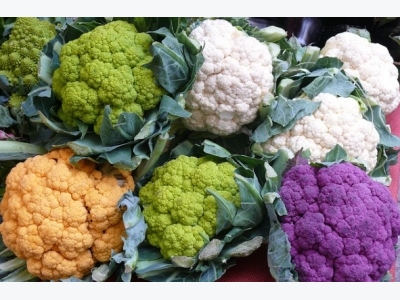Cauliflower Cultivation Information Guide

Introduction of Cauliflower Cultivation:- Cauliflower is one of the most daily consumed important vegetables of commercial crops in the world. Basically cauliflower is grown with seeds and belongs to the family of ” Brassicaceae”. The white part of flower is used for culinary purpose. The stalk and surrounding thick, green leaves are used in vegetable broth or can be fed as fodder for livestock. Scientific name of Cauliflower is “Brassica oleracea var. botrytis L.” and its family name is “Brassicaceae (Cruciferae). Cauliflower is a cruciferous vegetable and belongs to the same family as broccoli, kale, cabbage and collards vegetables. Surrounding the curd are ribbed, coarse green leaves that protect it from sunlight, impeding the development of chlorophyll. The cauliflower flowers are attached to a central stalk. Cauliflower is one of the famous vegetables consumed daily across the world. These wonderful cauliflowers can be grown in greenhouse or polyhouse.

Cauliflower Field.
Health Benefits of Cauliflower:- The following are the health benefits of Cauliflower.

Health Benefits of Cauliflower.
- Regular Consumption of cauliflower reduces certain types of cancer risks.
- Cauliflower good for pregnant women.
- Cauliflower aids in weight loss management.
- Cauliflower promotes heart health.
- Cauliflower builds healthy immune system.
- Cauliflower lowers blood cholesterol levels.
- Cauliflower detoxifies the body system.
- Cauliflower boosts vitamin ‘K’ and calcium content.
- Cauliflower is rich source of minerals
- Cauliflower is good for skin health.
Common Names of Cauliflower:- Cauliflower.
Local Names of Cauliflower in Other Parts of World:- Blumenkohl (German), Bloemkool (Dutch), Blomkool (Afrikaans), Coliflor ( Catalan), Kalafior (Polish), Phool/Gobi (Urdu), càl-colaig (Scottish), цэцэгт байцаа (Mongolian), lulelakër (Albanian), cvjetača/karfiol (Bosnian), koliplor (Cebuano), Lillkapsas(Estonian), Κουνουπίδι(Greek), Cóilis (Irish), 꽃양배추(Korean), Pastarda (Maltese),काउली/Kauli (Nepali), a couve-flor (Portuguese), карфиол (Serbian), Gulkaram (Uzbek), القرنبيط) Arabic), цветно зеле (Bulgarian),甘蓝 (Chinese), Kuliplor (Filipino), Cavolfiore (Italian), huā cài (Mandarin), Blomkål (Norwegian), dòk gà-làm (Thai), súp lơ or bông cải (Vietnamese), gàw-bì-pán (Burmese),korifurawā (Japanese), Ziedkāposts (Latvian), conopidă (Romanian), Květák (Czech), Chou Fleur (French),карфиол (Macedonian), капуста (Russian), blomkål (Swedish), Karnabahar (Turkish), Ukholifulawa (Zulu), blomkål (Danish),qvavilovani kombosto (Georgian), Karfiol (Hungarian), Kubis Bunga (Malay), Gol Kalam (Persian), 花椰菜 (Taiwanese), cvetača (Slovenian).
Local Names of Cauliflower in India:- Phool Gobi/ Gobi (Hindi), Gobi Puvvu/Cauliflower (Telugu), Kovippu/Cauliflower (Tamil), Hu Kosu/ Hookosau (Kannada), Phulkobi (Oriya), foolcopy (Bengali), ਗੋਭੀ (Punjabi) Phoolkobi (Assamese), fulkobi (Marathi), Koli Flower Fool Kobi (Gujarathi), Coliflower (Malayalam), Ful kobi (Konkani).
Varieties of Cauliflower:- There are many improved/hybrid varieties available for each region. Cauliflowers are available in green, purple, light yellow and white colors. Contact local horticulture department for suitable varieties of cauliflower in your region.
Climate Requirement for Cauliflower Cultivation:- Cauliflower prefers full sun but will grow in light shade as well. Usually, cauliflower crop thrives well in cool and slightly moist climate and produce best curds. The temperature range of 15°C to 20 °C is required for its optimum growth. When you plant early varieties, they require higher temperature and longer day lengths.
Soil Requirement for Cauliflower Cultivation:- Cauliflower can be grown in wide range of soils. However, deep loamy soils are most suitable for its cultivation and good yield. When it’s grown on large scale, make sure the soil has pH value of 5.0 to 6.0. This vegetable is very sensitive to high acidic value so use application of lime for controlling the acidity. It prefers well drained soils with good organic or welldecomposed farm yard manure.
Land Preparation for Cauliflower Cultivation:- Prepare the field by giving deep ploughing about 20 cm depth by local tractor or any cultivator. Make sure to have three cross-harrowing and 2 planking to make the surface smooth and level to get the soil to fine tilth stage.
Propagation in Cauliflower Cultivation:- Usually, propagation of cauliflower is done through seeds.
Seed Rate, Planting and Spacing in Cauliflower Cultivation:- Cauliflower seed are sown in nursery beds and seed rate for early crop is 600 to 800 grams and for late crop 400 to 550 grams per 1 hectare land. Cauliflower seedlings are prepared on nursery beds and 4 weeks seedlings are transplanted to main field. Generally, ridges and furrow type of layout is used for cauliflower crop. When it comes to plant spacing, for early crop is 45 cm X 45 cm is maintained where in late crop 60 cm X 60 cm is maintained.

Cauliflower Seeds.
Irrigation in Cauliflower Cultivation:- Irrigation at every stage of plant growth is very important, one should make sure to have proper irrigation facility. As cauliflower is a shallow-rooted crop and its roots are confined to 40 to 55 cm soil depth, drip irrigation is the most suitable irrigation method for uniform head size and high quality produce. Frequent irrigation is needed in hot/dry climatic conditions. There are many advantages of drip irrigation.

Drip Irrigation in Cauliflower Farming.
Manures and Fertilizers in Cauliflower Cultivation:- Balanced nutrients and timely fertilizers will result in excellent yields of any vegetable crop. In cauliflower farming, on an average of 20 to 25 tonnes of well decomposed farm yard manure (FYM) should be applied during land preparation. When it comes to inorganic fertilizers, 60 kg of “N”, 80 kg of “P2O5 and 40 kg of K20 per hectare should be applied before transplanting of cauliflower seedlings in main filed. Generally, fertigation of nitrogen through drip irrigation system in 5 to 6 split doses results in better yield.
Pruning in Cauliflower Cultivation:- Pruning is a task of removing unwanted stems/dead stems or diseased branches for controlling the plant structure or healthy growth. Practice the standard pruning activities such as removing dead/dries leaves/stems. Burn any diseased branches/plants. Pruning activity in cauliflower farming should be carried out on need base

Growing Cauliflower in Greenhouse-Polyhouse.
Weed Control in Cauliflower Cultivation:- In any crop, weed control is very important task for getting higher yields. As cauliflower is shallow root crop, practice shallow hoeing. If the crop is grown commercially, one can use plastic mulch for controlling weed growth and conserving moisture content at plant base.
Pests and Diseases in Cauliflower Cultivation:- Control of pests and diseases one of the major tasks in any vegetable farming.
Pests: Caterpillars, Cabbage fly, Cutworms, Aphids, Thrips, Flea beetles, Tarnished plant bugs, Slugs and Nematodes are common pests found in Cauliflower Cultivation.
Control Measures: Contact local horticulture department for these pest symptoms and preventive methods as they are the best source.
Diseases: Clubroot, Grey leaf spot and black leaf spot, Downey mildew, Rhizoctonia, Black leg, Black rot (Bacterial diseases) and fungal diseases (Damping-off).
Control Measures: Contact local horticulture department for these diseases symptoms and preventive methods as they are the best source.
Note: Crop rotation and selection of disease resistant seeds are most important factors from preventing most of the pests and diseases that commonly attack any vegetable crops.
Harvest in Cauliflower Cultivation:- Usually, the maturity of cauliflower or harvest time is determined when its curds attain a proper size and before they begin to discolour. Harvest the flowers with sharp sickle and grade/store them based on size before marketing.
Yield in Cauliflower Cultivation:- Well, when we speak about yield, it depends on many factors like, cultivar/variety, soil type, irrigation and other farm management practices. On an average, one can obtain a yield of 20 to 35 t/ha in early season to about 45 to 50 t/ha during mid-season
Marketing of Cauliflower:- Harvested fresh cauliflower can be graded based on size and quality. These vegetables can be transported to local markets or can have an agent who can buy these in bulk at your farm.
Related news
Tools

Phối trộn thức ăn chăn nuôi

Pha dung dịch thủy canh

Định mức cho tôm ăn

Phối trộn phân bón NPK

Xác định tỷ lệ tôm sống

Chuyển đổi đơn vị phân bón

Xác định công suất sục khí

Chuyển đổi đơn vị tôm

Tính diện tích nhà kính

Tính thể tích ao



 Aloe Vera Cultivation Information Guide
Aloe Vera Cultivation Information Guide  Cassava Farming Information Guide
Cassava Farming Information Guide